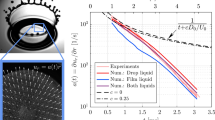Abstract
A volume of fluid (VOF) method is used to study the immiscible gas–liquid two-phase flow in a microchannel T-junction, through which the accurate interface of the Taylor bubble flow inside the micro-channel is captured and compared with visualization experiment of Taylor bubbles’ generation inside a T-junction microfluidic chip. The numerical results are in good agreement with the experimental measurements, which confirms the validation of our model. Then the length of gas–liquid slugs and velocity distribution inside slugs at various conditions are investigated with the superficial velocity of gas and liquid phase ranging from 0.01 to 0.90 m/s, and capillary number ranging from 6.4 ×10 − 4 to 1.7 ×10 − 2. A comprehensive description of mechanism of bubbles’ break-off is achieved and the transition capillary number from squeezing regime to shearing regime is found around 5.8 ×10 − 3. Finally the influences of fluid viscosity, surface tension of the gas–liquid interface and the velocity of both gas and liquid phases on the characteristic of the gas–liquid two-phase flow in micro-channel are also discussed in detail.
Similar content being viewed by others
References
Brackbill, J.U., Kothe, D.B., Zemach, C.: A continuum method for modeling surface tension. J. Comput. Phys. 100, 335–354 (1992)
Brivio, M., Verboom, W., Reinhoudt, D.N.: Miniaturized continuous flow reaction vessels: influence on chemical reactions. Lab Chip 6, 329–344 (2006)
Bugg, J.D., Mack, K., Rezkallah, K.S.: A numerical model of Taylor bubbles rising through stagnant liquids in vertical tubes. Int. J. Multiph. Flow 24, 271–281 (1998)
Burns, M.A., Johnson, B.N., Brahmasandra, S.N., et al.: An integrated nanoliter DNA analysis device. Science 282, 484–487 (1998)
Galbiati, L., Andreini, P.: Flow pattern transition for horizontal air-water flow in capillary tubes: a microgravity equivalent system simulation. Int. Commun. Heat Mass Transf. 21, 461–468 (1994)
Garstecki, P., Fuerstman, M.J., Stone, H.A., Whitesides, G.M.: Formation of droplets and bubbles in a microfluidic t-junction - scaling and mechanism of break-up. Lab Chip 6, 693–693 (2006)
Kolb, G., Hessel, V.: Micro-structured reactors for gas phase reactions. Chem. Eng. J. 98, 1–38 (2004)
Kumar, V., Vashisth, S., Hoarau, Y., Nigam, K.D.P.: Slug flow in curved microreactors: hydrodynamic study. Chem. Eng. Sci. 62, 7494–7504 (2007)
Madavan, N.K., Deutseh, S., Merkle, C.L.: Reduction of turbulent skin friction by micro-bubbles. Phys. Fluid. 7, 356–363 (1984)
Oliver, D.R., Wright, S.J.: Pressure drop and heat transfer in gas–liquid slug flow in horizontal tubes. Br. Chem. Eng. 9, 590–596 (1962)
Oishi, M., Kinoshita, H., Oshima, M., et al.: Investigation of micro droplet formation in a T-shaped junction using multicolor confocal micro PIV. In: 1st ASME Micro/Nanoscale Heat Transf. Int. Conf., Amer. Soc. Mech. Eng., pp. 297–301. TaiWan (2008)
Qian, D., Lawal, A.: Numerical study on gas and liquid slugs for Taylor flow in a T-junction microchannel. Chem. Eng. Sci. 61, 7609–7625 (2006)
Taha, T., Cui, Z.F.: Hydrodynamics of slug flow inside capillaries. Chem. Eng. Sci. 59, 1181–1190 (2004)
Taha, T., Cui, Z.F.: CFD modelling of slug flow inside square capillaries. Chem. Eng. Sci. 61, 665–675 (2006)
Utada, A.S., Lorenceau, E., Link, D.R., Kaplan, P.D., Stone, H.A., Weitz, D.A.: Monodisperse double emulsions generated from a microcapillary device. Science 308, 537–541 (2005)
van Steijn, V., Kreutzer, M.T., Kleijn, C.R.: μ-piv study of the formation of segmented flow in microfluidic t-junctions. Chem. Eng. Sci. 62, 7505–7514 (2007)
Veser, G.: Experimental and theoretical investigation of H2 oxidation in a high-temperature catalytic microreactor. Chem. Eng. Sci. 56, 1265–1273 (2001)
Xu, J.H., Li, S.W., Wang, Y.J., Luo, G.S.: Controllable gas–liquid phase flow patterns and monodisperse microbubbles in a microfluidic T-junction device. Appl. Phys. Lett. 88, 133506 (2006)
Author information
Authors and Affiliations
Corresponding author
Rights and permissions
About this article
Cite this article
Guo, F., Chen, B. Numerical Study on Taylor Bubble Formation in a Micro-channel T-Junction Using VOF Method. Microgravity Sci. Technol. 21 (Suppl 1), 51–58 (2009). https://doi.org/10.1007/s12217-009-9146-4
Received:
Accepted:
Published:
Issue Date:
DOI: https://doi.org/10.1007/s12217-009-9146-4




